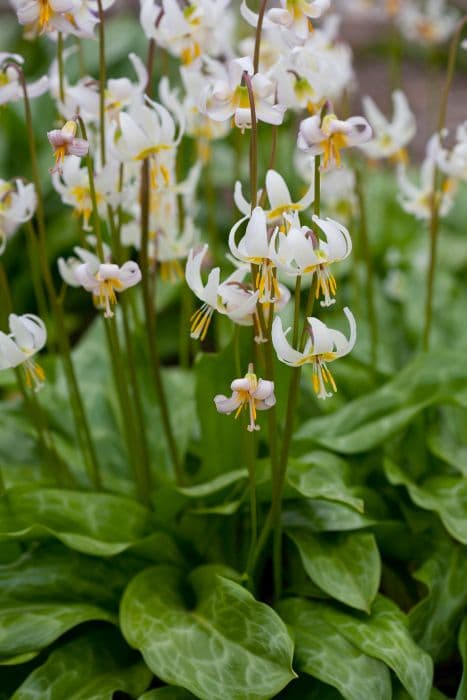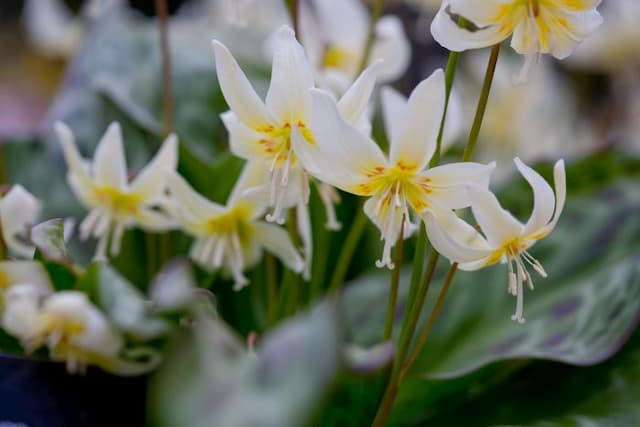Red Emperor Tulip Tulipa 'Madame Lefeber' (13)

ABOUT
The Tulipa 'Madame Lefeber', commonly known as the Red Emperor Tulip, is a striking variety known for its vibrant and showy flowers. The plant produces large, cup-shaped blooms that boast a rich red color, which can create a bold statement in any garden. The petals have a smooth texture and are known for their broad and slightly curved shape, coming to a soft point at the tips, which gives the impression of a classic tulip silhouette. The leaves of the Red Emperor Tulip are equally attractive, presenting a contrasting green hue. They are lance-shaped and can be somewhat glossy, emerging elegantly from the base of the stem. The foliage provides a lush backdrop that further accentuates the brilliance of the flowers. This tulip variety is appreciated for its early spring bloom, often being one of the first bursts of color seen in a garden after the winter months. The Red Emperor Tulip's flower boasts a prominent interior as well, typically marked by a yellow base, or sometimes a different shade, that highlights the interior of the petals and adds depth to its overall appearance. The center of the bloom hosts the reproductive parts, which include the stamens and pistil, but these details are less noticeable from a distance, as the rich red hue of the petals tends to command most of the visual attention. It is also worth noting that the stem of the Red Emperor Tulip is sturdy, supporting the weight of the substantial flower. The plant's structure enables it to withstand spring weather, allowing the blooms to stand proudly and create a captivating visual display. The Red Emperor Tulip is a cherished choice for gardeners looking to add a pop of color to their landscape during the early parts of the growing season.
About this plant
 Names
NamesSynonyms
Red Emperor Tulip, Fosteriana Tulip
Common names
Tulipa 'Madame Lefeber'
 Toxicity
ToxicityTo humans
The common name for Tulipa 'Madame Lefeber' is tulip. Tulips are generally not highly toxic to humans. However, ingestion of any part of the tulip can cause mild oral irritation, gastrointestinal upset, dizziness, or diarrhea in some individuals. If significant quantities are ingested, it can lead to more severe symptoms and may require medical attention.
To pets
The common name for Tulipa 'Madame Lefeber' is tulip. Tulips are considered toxic to pets, particularly cats and dogs. Ingestion of any part of the tulip can lead to symptoms such as vomiting, diarrhea, depression, hyper salivation, and in more severe cases, an increase in heart rate and difficulty breathing. It is especially the bulb that is more toxic compared to other parts of the plant. If you suspect your pet has ingested tulip bulbs, you should contact your veterinarian immediately.
 Characteristics
CharacteristicsLife cycle
Perennials
Foliage type
Deciduous
Color of leaves
Green
Flower color
Red
Height
1 feet 4 inches (40 cm)
Spread
6 inches (15 cm)
Plant type
Bulb
Hardiness zones
3-8
Native area
Asia Minor
Benefits
 General Benefits
General Benefits- Aesthetic Appeal: Adds vibrant color and beauty to gardens with its striking red blossoms.
- Landscape Design: Can be used in beds, borders, and as a focal point due to its distinctive appearance.
- Pollinator Attraction: Attracts bees, butterflies, and other beneficial pollinators, supporting biodiversity.
- Seasonal Interest: Blooms in spring, providing a lively display after the dull winter months.
- Cut Flowers: Suitable for bouquets and floral arrangements thanks to its long-lasting and showy flowers.
- Easy to Grow: Requires minimal care and is relatively easy for gardeners of all levels to cultivate.
- Propagation: Can be propagated by bulb division, allowing gardeners to increase their stock.
 Medical Properties
Medical PropertiesThis plant is not used for medical purposes.
 Air-purifying Qualities
Air-purifying QualitiesThis plant is not specifically known for air purifying qualities.
 Other Uses
Other Uses- Dye production: The petals of the tulip can be used to create natural dyes for fabrics, offering a range of colors depending on the mordant used.
- Edible garnish: The petals of the Tulipa 'Madame Lefeber' can be used to add color and a mild flavor to salads and desserts, as they are edible.
- Crafting eco-friendly confetti: Dried tulip petals can serve as a biodegradable alternative to traditional paper confetti for celebrations and events.
- Journaling and scrapbooking: Pressed tulip petals can be used for embellishing journals, scrapbooks, or for making bookmarks.
- Homemade potpourri: Dried tulip petals can be mixed with other flowers and spices to create a fragrant potpourri.
- Photography: Tulips can be used in floral photography and as subjects for botanical illustration due to their vibrant colors and shapes.
- Seasonal decoration: Intact flowers or individual petals can be used to decorate springtime wreathes or table settings.
- Teaching tool: The tulip can be used in educational settings to demonstrate various aspects of botany, including flower anatomy and pollination.
- Floral water: Tulip petals can be steeped in water to create a lightly fragrant floral water for use in home fragrancing or cosmetic applications.
- Mood enhancer: The bright colors and pleasant appearance of tulips can be used in color therapy and to improve the ambiance of a space.
Interesting Facts
 Feng Shui
Feng ShuiThe Tulip is not used in Feng Shui practice.
 Zodiac Sign Compitability
Zodiac Sign CompitabilityThe Tulip is not used in astrology practice.
 Plant Symbolism
Plant Symbolism- Perfect Love: The Tulip is often seen as a symbol of perfect, deep, or enduring love, due to its bold and impactful bloom which could be associated with strong emotions.
- Declaration of Love: In Persian folklore, giving a red tulip was a declaration of love; the Tulipa 'Madame Lefeber' with its vibrant color embodies this tradition.
- Temporary Nature of Life: Because tulips bloom in spring and have a relatively short life span, they can represent the fleeting nature of existence and remind us to enjoy the present.
- Fame & Success: Some cultures associate the tulip with fame and success because its flower stands tall and prominent, suggesting an individual standing above the rest.
- Royalty: The majestic appearance of the tulip, including the 'Madame Lefeber', can symbolize regal power and elegance, owing to its rich and vibrant colors.
 Water
WaterThe Red Emperor Tulip should be watered thoroughly when the soil feels dry to the touch, which can vary depending on climate conditions but generally every 7 to 10 days. During the active growing season, in the spring, ensure the soil is kept moist but not soggy, providing about 1 inch of water per week. After blooming, reduce watering to allow the foliage to die back naturally. Overwatering can lead to bulb rot, so it is crucial to have well-draining soil. During the dormant season, in the summer and fall, watering can be ceased as the bulb is resting.
 Light
LightRed Emperor Tulips thrive in full sun to partial shade, with at least 6 hours of direct sunlight per day. An area that receives morning sunlight and some afternoon shade is ideal to protect the blooms from intense, late-day sun. Ensure they are planted where they are protected from harsh winds that can damage the stems and blooms.
 Temperature
TemperatureRed Emperor Tulips prefer cooler climates and can survive winter temperatures as low as -40 degrees Fahrenheit. Their ideal growing temperature during the day is between 60 and 70 degrees Fahrenheit with cooler night temperatures. It's essential to protect them from extreme heat; if temperatures exceed 80 degrees Fahrenheit, the blooms may fade quickly.
 Pruning
PruningPruning Red Emperor Tulips involves deadheading the spent flowers after they have bloomed to prevent seed production, which can divert energy from the bulb. Prune the flower stem back to the first leaf once the petals fall, but leave the foliage intact until it turns yellow and dies back naturally, usually a few weeks after flowering. This allows the plant to photosynthesize and store energy for the next season.
 Cleaning
CleaningNot needed
 Soil
SoilFor the best soil mix for Tulip 'Madame Lefeber', use well-draining sandy or loamy soil enriched with compost. The ideal pH for this tulip variety should be between 6.0 and 7.0, slightly acidic to neutral.
 Repotting
RepottingTulip 'Madame Lefeber' is typically grown from bulbs and does not need repotting. Instead, bulbs should be lifted and divided every 3-5 years to prevent overcrowding and maintain vigor.
 Humidity & Misting
Humidity & MistingTulip 'Madame Lefeber' prefers average humidity levels and does not require special humidity conditions, as it is naturally adapted to outdoor climates where humidity varies with the weather.
 Suitable locations
Suitable locationsIndoor
Place in bright, indirect light; ensure cool temperatures.
Outdoor
Plant bulbs in autumn, full sun to part shade.
Hardiness zone
3-8 USDA.
 Life cycle
Life cycleTulipa 'Madame Lefeber', commonly known as Red Emperor Tulip, begins its life as a bulb planted in the fall before the first frost. In the spring, the bulb, using stored nutrients, sprouts and produces lance-shaped leaves and a sturdy stem. Upon maturation, the stem bears a single, large, cup-shaped, red flower that blooms early in the tulip season. After the flowering phase, the blooms wither and the plant focuses energy on replenishing the bulb for the next season. During summer, the foliage yellows and dies back as the bulb enters dormancy. The cycle repeats the following spring when temperatures rise, completing the annual growth cycle of the Red Emperor Tulip.
 Propogation
PropogationPropogation time
Spring
Tulipa 'Madame Lefeber', commonly known as Fosteriana Tulip, is typically propagated through a method of dividing and replanting the plant's bulbs. The best time for propagation is in the fall, as tulip bulbs require a period of cold dormancy to bloom successfully in the spring. To propagate by bulb division, gardeners should carefully dig up the tulip bulbs after the foliage has died back post-blooming, usually in late spring or early summer. They should then gently separate the smaller offset bulbs, which form around the base of the mother bulb, from the main bulb. These offsets can be replanted at a depth of about 6 to 8 inches (15 to 20 centimeters) in well-drained soil with the pointed end facing upwards, spaced approximately 4 to 6 inches (10 to 15 centimeters) apart to allow for adequate growing room. It's important to ensure the planting site receives full to partial sunlight to foster robust growth. The new plantings will undergo root development during the fall and winter, preparing them to emerge as healthy, blooming flowers in the following spring.








